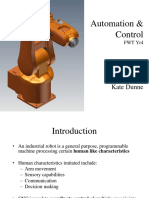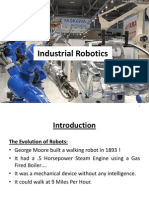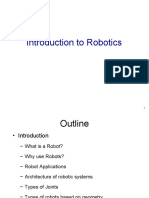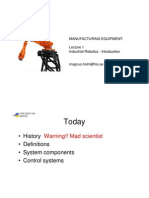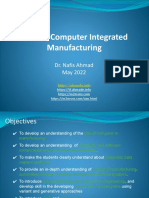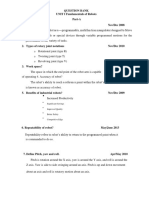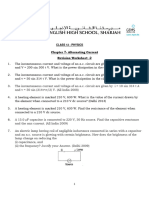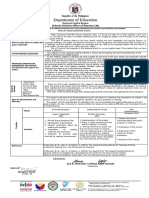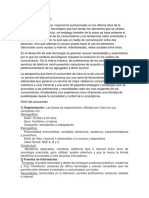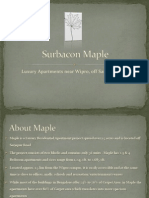0 ratings0% found this document useful (0 votes)
22 views78 pagesUnit II - Robot Components
Uploaded by
Varsha SundareswaranCopyright
© © All Rights Reserved
We take content rights seriously. If you suspect this is your content, claim it here.
Available Formats
Download as PDF, TXT or read online on Scribd
0 ratings0% found this document useful (0 votes)
22 views78 pagesUnit II - Robot Components
Uploaded by
Varsha SundareswaranCopyright
© © All Rights Reserved
We take content rights seriously. If you suspect this is your content, claim it here.
Available Formats
Download as PDF, TXT or read online on Scribd
You are on page 1/ 78
UNIT II – ROBOT
COMPONENTS
Fundamentals of Robot Technology – Automation and
Robotics – Robot anatomy – Work volume – Precision of
movement – End effectors - Sensors
Fundamentals of robot technology
– automation and robotics
• Automation and robotics are two closely related technologies.
• In an industrial context, we can define automation as a
technology that is concerned with the use of mechanical,
electronic, and computer-based systems in the operation and
control of production.
• Examples of this technology include transfer lines, Mechanized
assembly machines, feedback control systems (applied to
industrial processes), numerically controlled machine tools, and
robots.
• Accordingly, robotics is a form of industrial automation.
• Example: Robotics, CAD/CAM, FMS, CIMS
Types of automation
Automation is categorized into three
types,
1.Fixed Automation
2.Programmable Automation
3.Flexible Automation
Fixed Automation
• It is the automation in which the sequence of processing or
assembly operations to be carried out is fixed by the equipment
configuration.
• In fixed automation, the sequence of operations (which are simple)
are integrated in a piece of equipment.
• Therefore, it is difficult to automate changes in the design of the
product.
• It is used where high volume of production is required.
• Production rate of fixed automation is high.
• In this automation, no new products are processed for a given
sequence of assembly operations.
Fixed Automation – Features
•High volume of production rates
•Relatively inflexible in product variety
(no new products are produced)
Example: Automobile industries
Programmable Automation
• It is the automation in which the equipment is designed to accommodate
various product configurations in order to change the sequence of
operations or assembly operations by means of control program.
• Different types of programs can be loaded into the equipment to produce
products with new configurations (i.e., new products).
• It is employed for batch production of low and medium volumes.
• For each new batch of different configured product, a new control program
corresponding to the new product is loaded into the equipment.
• This automation is relatively economic for small batches of the product.
Programmable Automation -
Features
• High investment in general purpose
• Lower production rates than fixed automation
• Flexibility & Changes in products configuration
• More suitable for batch production
Example: Industrial robot, Numerical Control (NC)
machines tools, etc.
Flexible Automation
• It possess some of the features of both fixed and programmable
automation.
• A computer integrated manufacturing system which is an extension
of programmable automation is referred as flexible automation –
different products at same time on same manufacturing system.
• It is developed to minimize the time loss between the changeover of
the batch production from one product to another while reloading the
program to produce new products and changing the physical setup
i.e., it produces different products with no loss of time.
• This automation is more flexible in interconnecting workstations with
material handling and storage system.
Flexible Automation- Features
• High investment for a custom engineering system
• Medium Production rates
• Flexibility to deal with product design variation
• Continuous production of variable mixtures of
products
Example: Flexible manufacturing systems (FMS),
CIMS.
Relationship of
fixed,
programmable
and flexible
automation as a
function of
production volume
& product variety
Fundamentals of robot technology
• Robot anatomy
• Work volume
• Drive systems
• Control systems and dynamic performance
• Precision of movement
• End effectors
• Sensors
Robot anatomy
• Concerned with physical construction of the body, arm and
wrist of the machine.
• Robots mounted on a base
• Body is attached to a base and arm assembly is attached to
the body
• At the end of the arm is wrist – consists of a number of
components that allow it to be oriented in a variety of
positions.
• Body, arm and wrist assembly - manipulator
Manipulator
• Consists of joints and links – joints provide
relative motion, links are rigid members
between joints
• Various joint types: linear and rotary
• Each joint provides a "degree-of-freedom"
• Most robots possess 5 or 6 degrees-of-
freedom
• Manipulator consists of 2 sections: body and
arm – for positioning of objects in the robot's
work volume, wrist assembly – for orientation
of objects
4 common robot configurations /
Anatomies
Classification by co-
ordinate system
1. Polar configuration
2. Cylindrical configuration
3. Cartesian coordinate
configuration
4. Jointed-arm
configuration
Polar configuration
• The polar configuration uses a telescoping
arm that can be raised or lowered about a
horizontal pivot.
• The pivot is mounted on a rotating base.
• These various joints provide the robot with
the capability to move its arm within a
spherical space, and hence the name
“spherical coordinate” robot is sometimes
applied to this type.
• A number of commercial robots possess the
polar configuration.
• Example: Unimate 2000 series, MAKER 110
(US).
Unimate 2000 series & MAKER 110
(US)
Cylindrical configuration
• The cylindrical configuration uses a
vertical column and a slide that can
be moved up or down along the
column.
• The robot arm is attached to the slide
so that it can be moved radially with
respect to the column.
• By rotating the column, the robot is
capable of achieving a work space
that approximation a cylinder.
• Example: GMF Model M-1A
GMF Model M-1A
Cartesian coordinate configuration
• The cartesian coordinate robot uses three
perpendicular slides to construct the x, y,
and z axes.
• Other names are xyz robot and rectilinear
robot.
• By moving the three slides relative to one
another, the robot is capable of operating
within a rectangular work envelope.
• Example: IBM RS-1 robot (currently called
Model 7565) - box configuration, Gantry
robot – large and have gantry-type crane.
IBM RS-1 robot
Jointed-arm configuration
• The jointed-arm robot is similar to that of the
human arm.
• It consists of two straight components.
• Corresponding to the human forearm and
upper arm, mounted on a vertical pedestal.
• These components are connected by two
rotary joints corresponding to the shoulder
and elbow.
• Wrist attached to the end of forearm provides
several additional joints.
• Example: Cincinnati Milacron T3 (Model 776)
robot.
Cincinnati Milacron T3 (Model 776)
robot
SCARA – special version of jointed
arm robot
• Selective Compliance
Assembly Robot Arm
• Its shoulder and
elbow joints rotate
about vertical axes.
• Ideal for many
assembly tasks.
General Advantages and
disadvantages
• Repeatability of motion – capability to move to a taught
point in space with minimum error – box-frame cartesian
robot
• Reach – ability to extend its arm significantly beyond its
base – polar and jointed arm configurations
• Lift capacity – high rigid and load carrying capacity –
cylindrical and gantry xyz robot
• Machine loading applications – polar and cylindrical
configurations.
Robot motions – degrees of freedom
• Industrial robots are designed to perform productive work such as
pick and place, welding, assembly, etc.
• It is accomplished by enabling the robot to move its body, arm and
wrist through a series of motion and positions.
• The individual joint motions associated with the performance of a
task are referred to Degrees of Freedom (DOF)
• "Degrees of freedom" are specific, defined modes in which a
mechanical device or system can move.
• The number of degrees of freedom is equal to the total number of
independent displacements or aspects of motion.
• Typical industrial robot – 4 to 6 degrees of freedom
Joints and its types
• All industrial robots have mechanical joints that can be classified into one of the
five types.
• Two types that provide translational motion and three types that provides rotating
motions.
• Linear joint (type L joint)
• Orthogonal joint (type O joint)
• Rotational joint (type R joint)
• Twisting joint (type T joint)
• Revolving joint (type V joint)
• In a link-joint-link chain -> link closest to base is input link and o/p link moves w.r.t
input link
Linear joint
(type L joint) /
prismatic joint
• Sliding or
translational motion
of connecting links
with the axes of the
two links parallel.
Orthogonal
joint (type
O joint)
• also a translational /
sliding motion but
the input and output
links are
perpendicular to
each other during
the move
Rotational
joint (type
R joint)
• Axis of rotation is
perpendicular to
axes of 2 connecting
links
Twisting
joint (type T
joint)
• Twisting motion
between I/p and o/p
link
• the axis of rotation
is parallel to the
axes of the two links
Revolving
joint (type
V joint)
• I/p link is parallel to
axis of rotation
• o/p link is
perpendicular to
axis of rotation
• o/p link revolves
about I/p link as if it
were in orbit
Dof associated with arm and body
motions
For robots of polar, cylindrical and jointed-arm configuration, 3
DOF associated with arm and body motions are as follows,
• Vertical Traverse: This is the capability to move the wrist up or
down to provide the desired vertical attitude.
• Radial Traverse: This is the capability to move the wrist front
and back (in/out movement) which provides the extension and
retraction movement.
• Rotational Traverse: This is the capability to rotate the arm in
vertical axis.
polar
coordinat
e robot –
3 dof
Cartesian coordinate robot – 3 dof
• Vertical movement – z axis motion
• In and out movement – y axis motion
• Right / left movement – x axis motion
• Achieved by corresponding movements of 3 orthogonal
slides of robot arm
Wrist movement - Degrees of Freedom
associated with wrist of robot
• Enable robot to orient the end effector properly w.r.t
task
• Normally provided with 3 DOF
• Wrist Roll: Also called as wrist swivel, this involves
rotation of the wrist mechanism about the arm axis
• Wrist Pitch: Given that the wrist roll is in the center
position, the pitch would involve the up and down
rotation of the wrist. This is also sometimes called a s
wrist bend
• Wrist Yaw: Given that the wrist roll is the center
position, the Yaw would involve the right or left
rotation of the wrist.
Notation scheme for designating
robot
• Robot configuration – arm
• Robot configuration
and body and its symbol
– wrist and symbol
• Polar - TRL
• Two-axis wrist
• Cylindrical – TLL, LTL, LVL (typical) - RT
• Cartesian coordinate - LLL • 3 – axis wrist
• Jointed arm – TRR, VVR (typical) - TRT
Including both arm & body and wrist
joints
• Polar coordinate robot – designated as TRL : TRT
• If the motion of the robot is linear (fastened to a
platform on wheels that can be driven along a track
between several machine tools) - designated as L – TRL
: TRT , here eventhough the wheels rotate, motion of
robot is linear
Work volume
Determined by following
ØWork volume shape
physical characteristics of
ØPartial sphere - polar
robot,
ØCylinder - cylindrical
Robot's physical ØRectangular -
configuration
cartesian
Sizes of body, arm and ØSpherical - jointed-
wrist components arm
Limits of robot's joint
movements
Work volume for polar, cylindrical
and cartesian configuration
Robot drive systems
• The robot’s capacity to move its body, arm, and
wrist is provided by the drive system used to power
the robot.
• The drive system determines,
1. speed of the arm movements,
2. load carrying capacity,
3. its dynamic performance, and
4. kinds of applications that the robot
can accomplish.
Types of drive systems – for Commercially
available industrial robots
HYDRAULIC ELECTRIC PNEUMATIC
Hydraulic drive and electric drive are the two main
types of drives used on more sophisticated robots,
while pneumatic drive is used for low load carrying
capacity robots and in cases where oil and electricity
cannot be used (fire hazard).
Hydraulic drive systems
• Generally associated with larger robots – Unimate 2000
series
• Advantages - it provides the robot with greater speed
and strength.
• Disadvantages - it typically adds to the floor space
required by the robot, and is inclined to leak oil which is
a nuisance.
• Hydraulic drive systems can be designed to actuate
either rotational joints or linear joints.
• Rotary vane actuators can be utilized to provide rotary
motion
• Hydraulic pistons can be used to accomplish linear
motion.
Block diagram:(Hydraulic)
Electric drive systems
• Do not generally provide as much speed or power as hydraulic
systems.
• Accuracy and repeatability are usually better.
• Electric robots - smaller, requiring less floor space, and their
applications tend toward more precise work such as assembly,
actuated by dc stepping motors or dc servomotors.
• These motors are ideally suited to the actuation of rotational
joints through appropriate drive train and gear systems.
• Electric motors can also be used to actuate linear joints (e.g.,
telescoping arms) by means of pulley systems or other
translational mechanisms.
• Example – the MAKER 110
Block Diagram:(Electric)
Hydraulic vs electric drive systems
• The economics of the two types of drive systems are
also a factor in the decision to utilize hydraulic drive on
large robots and electric drive on smaller robots.
• Cost of an electric motor is much more proportional to
its size, whereas the cost of a hydraulic drive system is
somewhat less dependent on its size.
• Cost vs size graph shows that there is a hypothetical
break-even point below which it is advantageous to use
electric drive and above it is appropriate to use
hydraulic drive.
• There is a trend in the design of industrial robots
toward all electric drives, and away from hydraulic
robots because of the disadvantages discussed above.
Pneumatic drive systems
• Reserved for smaller robots that possess
fewer degrees of freedom (two to four-joint
motions).
• These robots are often limited to simple pick-
and-place operations with fast cycles.
• Can be readily adapted to the actuation of
piston devices to provide translational
movement of sliding joints.
• It can also be used to operate rotary actuators
for rotational joints.
Block Diagram(Pneumatic )
Speed of motion
• Speed capabilities – maximum of about 1.7 m/s (5 ft/sec)
• Speed – measured at the wrist
• Highest speeds – obtained by larger robots (arm
extended to its max. distance from the vertical axis)
• Hydraulic robots – faster than electric drive robots
• Speed – determines how quickly a given work cycle can
be accomplished which is desirable in production to
minimise the cycle time of a given task
Speed of motion (Contd.....)
Determination of most
desirable speed depends on,
• Accuracy with which the wrist (end effector) must be
positioned – inverse relationship between accuracy &
speed
• Weight of the object being manipulated – in case of
heavier objects (greater inertia & momentum), robot must
be operated more slowly.
• Distances to be moved – because of acceleration & Influence of distance versus speed
deceleration problems, a robot is capable of traveling one
long distance in less time than a sequence of short
distances whose sum is equal to the long distance as
depicted in the figure.
Load-carrying capacity
• Size, configuration, construction, and drive system – determine load-carrying
capacity of the robot
• Should be specified under the condition that robot's arm is in its weakest position –
in case of polar, cylindrical or jointed-arm configuration, the arm is at max.
extension (similar to that of human arm)
• Rated Weight carrying capacities – less than a pound for small robots to several
1000 pounds for very large robots
• Example – Prab Versatran Model FC – 2000 lb, MAKER 110 – 5 lb.
• Manufacturer's specification of this feature is gross weight capacity – here end
effector weight must be considered
• Example – if rated load capacity of a given robot were 5 lb, end effector weighed 2
lb, then net weight-carrying capacity would be only 3 lb.
Control systems
• Control its drive systems – to properly
regulate its motions
• 4 types of robot controls,
1. Limited-sequence robots – lowest level of
control
2. Playback robots with point-to-point control
3. Playback robots with continuous path
control
4. Intelligent robots – most sophisticated
Limited sequence robots
• do not use servo-control to indicate • The sequence in which the motion
relative positions of the joints. cycle is played out is defined by a
pegboard or stepping switch or other
• Controlled by setting limit switches and/or
sequencing device.
mechanical stops to establish the
• This device, which constitutes the
endpoints of travel for each of their joints.
robot controller, signals each of the
• Involves a mechanical set-up of the particular actuators to operate in the
manipulator rather than robot proper succession.
programming • No feedback is associated to indicate
• Individual joints can only be moved to their that the desired position has been
extreme limits of travel. achieved.
• Any of the three drive systems can be
• This has the effect of severely limiting the used; pneumatic drive be the most
number of distinct points that can be commonly employed type.
specified in a program for these robots. • Applications - pick-and-place
operations.
Playback robots
• use a more sophisticated control unit in which a series of positions or motions are
“taught” to the robot, recorded into memory, and then repeated by the robot under
its own control.
• This general mode of operation - “playback”.
• Procedure of teaching and recording into memory is referred to as programming
the robot.
• Playback robots usually have some form of servo-control (e.g., closed loop
feedback system) to ensure that the positions taught have been achieved
• Playback robots can be classified into two categories: point-to-point (PTP) robots
and continuous-path (CP) robots.
Playback robots with point-to-point
control
• Capable of performing motion cycles - a series of desired point locations and related
actions.
• The robot is taught each point, and these points are recorded into the robot’s control unit.
• During playback, the robot is controlled to move from one point to another in the proper
sequence.
• PTP robots do not control the path taken by the robot to get from one point to the next.
• If the programmer wants to exercise a limited amount of control over the path followed, this
must be done by programming a series of points along the desired path.
• Control of sequence of positions is quite adequate for many kinds of applications - loading
and unloading machines and spot welding.
Playback robots with continuous path
control
• Capable of performing motion cycles in which • Some robots have the capability to follow
the path followed by the robot is controlled; a smooth, curved path that has been
defined by a programmer who manually
accomplished by making the robot move
moves the arm through the desired
through a series of closely spaced points
motion cycle.
which describe the desired path. • To achieve CP control to more than a
• Individual points - defined by the control unit limited extent requires that the controller
rather than the programmer. unit be capable of storing a large number
of individual point locations that define
• Straight line motion - common form of the compound curved path.
continuous-path control. • Involves digital computer (a
microprocessor - central processing unit
• The programmer specifies the starting point
for the computer) as the robot controller.
and the end point of the path, and the control
• CP control is required for certain types of
unit calculates the sequence of individual industrial applications - spray coating
points that permit the robot to follow a straight and arc welding.
line trajectory.
Intelligent robots
• Not only play back a programmed motion cycle • Kinds of applications that are performed
but also interact with its environment - intelligent. by intelligent robots rely on the use of a
• Controller unit consists of a digital computer or high-level language to accomplish the
similar device (programmable controller). complex and sophisticated activities.
• Typical applications - assembly tasks,
• Can alter their programmed cycle in response to space applications, under sea, nuclear
conditions that occur in the workplace, make applications, defense applications, etc.
logical decisions based on sensor data received
• Intelligent robots- made possible by the
from the operation, communicate during the work
availability of cheap electronics, smaller
cycle with humans or computer based systems.
and faster processors and smart
• Programmed using an English-like symbolic materials-based actuators and sensors.
language, unlike a computer programming
language.
Speed of response and stability – 2 important
characteristics of dynamic performance
• Speed of response – capability of a robot to move to the
next position in a short amount of time – related to
robot's speed of motion
• Stability – measure of the oscillations which occur in
the arm during movement from one position to the next;
little or no oscillations – good stability and large amount Low damping – fast response
of oscillations – poor stability
• Stability – controlled by incorporating damping elements
(actuators and sensors) into the robot's design
• High level of damping – increase robot's stability but
reduces the speed of response as illustrated in the
figures
high damping – slow response
Precision of movement
• A robot is expected to perform repeated tasks in a real world
• Its performance is ultimately measured by its ability to position
and orient the end effector at the desired location a large
number of times.
• Precision defined as a function of three features,
1. Spatial Resolution
2. Accuracy
3. Repeatability
Easier to define these in a static context rather than dynamic
Precision of movement
These terms will be defined based on following assumptions,
• Will apply at robot’s wrist end with no hand attached to the wrist
• Worst case conditions – robot’s precision will be at its worst –
Robot’s arm fully extended (incase of jointed arm / polar config.)
• Point-to-point robot – robot’s capability to achieve a given
position within its work volume
Spatial Resolution
• smallest increment of movement into which the robot can divide its work volume.
• Depends on two factors:
1. the system’s control resolution and
2. the robot’s mechanical inaccuracies.
• The control resolution is determined by the robot’s position control system and its feedback
measurement system.
• It is the controller's ability to divide the total range of movement for a particular joint into
individual increments (addressable points) - depends on the bit storage capacity in the
control memory.
• No. of addressable points for a particular axis, = 2^n (No. Of increments); n – no. of bits in
the control memory.
• For eg, a robot with 8 bits of storage can divide the range into 256 discrete positions
example
Using robot with 1 degree of freedom, lets assume it has one
sliding joint with a full range of 1 m (39.37 in.). The robot's control
memory has a 12-bit storage capacity. Determine the control
resolution for this axis of motion.
Soln: No. of increments = 2^n = 2^12 = 4096
Total range = 1m = divided into 4096 increments
Each position will be separated by = 1m / 4096 = 0.000244m or
0.244mm
Control resolution = total range / No. of increments = 0.244mm or
0.0096 in.
Spatial Resolution
• Incase of several degrees of freedom, control resolution for
each joint have to summed vectorially
• Total control resolution depends on wrist, arm and body motions
• Since some joints are rotary and others are sliding, control
resolution be a complicated quantity to determine.
Spatial Resolution - Mechanical
inaccuracies
• It’s in robot’s links and joint components and its feedback
measurement system (servo-controlled robot) – these
contributes to spatial resolution
• It is due to, 1) elastic deflection in structural members, 2) Gear
backlash, 3) stretching of pulley cords, 4) Leakage of hydraulic
fluids, etc.
• It’s worse for larger robots ie, errors are magnified by larger
components
Spatial Resolution - Mechanical
inaccuracies
• It’s influenced by,
1) Load being handled,
2) Speed with which arm is moving
3) Condition of maintenance of robot, etc
• Spatial resolution – control resolution degraded by mechanical
inaccuracies
• SR - improved by increasing bit capacity of control memory, but this
provides only little additional benefit because mechanical
inaccuracies become dominant component in SR
Accuracy
• Robot’s ability to position its wrist end at a desired target
point within the work volume.
• The accuracy of a robot can be defined in terms of spatial
resolution because the ability to achieve a given target
point depends on how closely the robot can define the
control increments for each of its joint motion
• In the worst case, the desired point would be in the middle
between two adjacent control increments. Ignoring
Mechanical inaccuracies, Robot’s accuracy is defined as
one-half of control resolution. This relation ship is shown in
fig 1
• In fact, the mechanical inaccuracies would affect the ability
to reach the target position, Accordingly, the robot’s
accuracy is defined as one-half of its spatial resolution as
shown in fig 2
Accuracy
• It’s affected by several factors,
i) Varies within work volume – it’s worse when arm is in outer range
of its work volume and is better when arm is closer to its base
since mechanical inaccuracies are magnified with robot’s arm fully
extended; error map – characterize the level of accuracy as a
function of location in work volume
ii) Accuracy is improved if motion cycle is restricted to limited work
range since mechanical errors tend to be reduced
iii) Load being carried – heavier workloads have greater deflection of
mechanical links resulting in lower accuracy
Accuracy
• Local accuracy – robot’s ability to reach a particular reference
point within limited work space
• Global accuracy – when its assessed within robot’s full work
volume
Repeatability
• is concerned with the robot’s ability to position its
wrist or an end effector attached to its wrist at a point
in space that had previously been taught to the robot.
• Repeatability and accuracy refer to two different
aspects of the robot’s precision. Accuracy relates to
the robot’s capacity to be programmed to achieve a
given target point.
• Actual programmed point is different from target
point due to control resolution limitations
• Repeatability refers to the robot’s ability to return to
the programmed point when commanded to do so.
• Desired target point is T
Repeatability
• During teach procedure, Robot is commanded to move to
point T
• Because of limitations on its accuracy, programmed position
becomes point P
• Distance between T and P – manifestation of robot’s
accuracy
• Then it’s instructed to return to exact position; instead it
returns to position R
• Difference between P and R – result of limitations on robot’s
repeatability
• Robot will not always return to same position R on
subsequent repetitions of motion cycle; instead it forms a
cluster of points on both sides of position P
• Repeatability errors form a RV and constitute a statistical
distribution
• Its better / convenient – if repeatability errors formed a nice
bell-shaped curve (normally distributed RV)
Repeatability
• Mechanical inaccuracies (responsible for these errors) donot form nice symmetric bell shaped distribution
• When errors from several axes of motion are combined, resulting aggregate error is influenced by central limit
theorem(probability)
• Theorem – sums of RVs tend to form a normally distributed variable, even though individuals come from other
distribution
• Repeatability error of a robot with 5 / 6 axes is approximately normal, even if error due to individual axis is not normal
• In 3D space, repeatability error will surround point P, forming a distribution whose outer boundary be conceptualized as
a sphere
• Robot manufacturer typically quotes – repeatability of its manipulator as radius of idealized sphere – specification (+ a
particular value)
• Size of sphere – larger in the regions of work volume away from center of robot
• Shape of sphere – not perfectly round but is oblong in certain directions due to compliance of robot arm
Compliance
• The compliance of the robot manipulator refers to the displacement of the
wrist end in response to a force or torque exerted against it.
• A high compliance means that the wrist is displaced by a large amount by a
relatively small force. The term springy is sometimes used to describe a
robot with high compliance.
• A low compliance means that the manipulator is relatively stiff and is not
displaced by a significant amount
• Robot manipulator compliance is a directional feature. That is, the
compliance of the robot arm will be greater in certain directions than in
other directions because of the mechanical construction of the arm.
• Compliance is important because it reduces the robot’s precision of
movement under loaded conditions (due to deflection of manipulator).
End effectors
• the term ‘end effector’ is used to describe the hand or tool that is attached to the robot’s wrist. The end effector
represents the special tooling that permits the general purpose robot to perform a particular application. This
special tooling must usually be designed specifically for the application.
• End effectors can be divided into two categories: grippers and tools.
• Grippers would be utilised to grasp an object, usually the work part, and hold it during the robot work cycle.
There are a variety of holding methods that can be used in addition to the obvious mechanical means of
grasping the part between two or more fingers.
• These additional methods include the use of suction cups, magnets, hooks and scoops.
• A tool would be used as an end effector in applications where the robot is required to perform some operation
on the work part. These applications include spot welding, arc welding, spray painting, drilling, etc.
• In each case the particular tool is attached to the robot’s wrist to accomplish the application
• With the recent need for holding micro and nano size parts for assembly, several new devices have been
developed using smart actuators, PZT and ionic polymers etc
End effectors
• Mechanical grippers (gripper force equation, analysis)
• Other types – vacuum cups, magnetic grippers, adhesive grippers, hooks,
scoops
• Tools – spot welding tools, arc-welding torch, spray-painting nozzle,
rotating spindles – drilling, routing, wire brushing, grinding; liquid cement
applicators for assembly, heating torches, water jet cutting tool
• Considerations in gripper selection and design(part to be handled,
actuation method, power and signal transmission, gripper force,
positioning problems, service conditions, operating environment,
temperature protection, fabrication materials); robot and end effector
interface
Robotic sensors
• Sensors used in robotics can be divided into external sensors and internal sensors.
• External sensors are used for interacting with the environment, while internal sensors are required to close the loop for
feedback control.
• A robot working in closed loop cannot work without internal sensors. A few examples of sensors are
• (a) External Sensors: vision, force torque, proximity etc.
• (b) Internal Sensors: position, velocity, acceleration
• Sensors are not only required for working of the robot and interacting with environment, but also for safety and work cell
control and monitoring
• Among all the external sensors vision is the most versatile and can be used for several applications.
• Vision systems can be used to locate objects for manipulation, measure their dimensions, detect intrusions in the work cell etc.
• A robot has to communicate with other machines and devices and this also depends on several sensor information.
• Simple sensors are used to detect the presence of a part on a conveyer, completion of a task, forces or torques being applied in
an assembly task etc.
Robotic sensors
• Tactile – respond to contact forces with another object,
measure level of force involved
• Proximity – indicates when an object is close to another object
before contact has been made and range sensor – distance
between objects can be sensed
• Miscellaneous – temperature, pressure
• Machine vision – viewing workspace, interpreting what it sees,
perform inspection, parts recognition
You might also like
- Industrial Robotics: Prashanth BN Assistant Professor Department of Mechanical Engineering Amrita School of EngineeringNo ratings yetIndustrial Robotics: Prashanth BN Assistant Professor Department of Mechanical Engineering Amrita School of Engineering52 pages
- Manufacturing Equipment: Industrial Robotics - Introduction Industrial Robotics - IntroductionNo ratings yetManufacturing Equipment: Industrial Robotics - Introduction Industrial Robotics - Introduction42 pages
- A & R Module - 3 Automated Production LineNo ratings yetA & R Module - 3 Automated Production Line21 pages
- Unit-I: Robotics and Automation. This Includes "Dumb" Ro Woodworking Machines, "Intelligent" WashingNo ratings yetUnit-I: Robotics and Automation. This Includes "Dumb" Ro Woodworking Machines, "Intelligent" Washing27 pages
- Lecture Notes: ON Advance Manufacturing &Cad/CamNo ratings yetLecture Notes: ON Advance Manufacturing &Cad/Cam23 pages
- Actuators & Sensors For Robot: DNT352 Industrial Robotics & AutomationNo ratings yetActuators & Sensors For Robot: DNT352 Industrial Robotics & Automation77 pages
- Chapter 7 - Revision Worksheet 2 - Alternating CurrentNo ratings yetChapter 7 - Revision Worksheet 2 - Alternating Current5 pages
- Mind, Language and Society Philosophy in The Real WorldNo ratings yetMind, Language and Society Philosophy in The Real World189 pages
- Product Guide: Hyundai Construction Equipment100% (1)Product Guide: Hyundai Construction Equipment26 pages
- Unit 2 Lesson 1: Opening The Lesson 5 MNNo ratings yetUnit 2 Lesson 1: Opening The Lesson 5 MN8 pages
- Endemism: Definition, Types, and ExamplesNo ratings yetEndemism: Definition, Types, and Examples39 pages
- Error Detection and Correction in Communication Systems Project50% (2)Error Detection and Correction in Communication Systems Project16 pages
- 1) Segmentación: Las Bases de Segmentación Utilizada Por Claro en SusNo ratings yet1) Segmentación: Las Bases de Segmentación Utilizada Por Claro en Sus5 pages
- Theory 2 - Code of Ethics For Professional Teacher & Historical Development of TeachingNo ratings yetTheory 2 - Code of Ethics For Professional Teacher & Historical Development of Teaching5 pages
- The Group Effect Social Cohesion and Health Outcomes Readable PDF Download100% (13)The Group Effect Social Cohesion and Health Outcomes Readable PDF Download14 pages
- Namma Kalvi 12th Commerce Book Inside One Mark Study Material EM 220550No ratings yetNamma Kalvi 12th Commerce Book Inside One Mark Study Material EM 220550145 pages
- Reviewing Strategies Used by Grade 12 Science, Technology, Engineering, and Mathematics Honor StudentsNo ratings yetReviewing Strategies Used by Grade 12 Science, Technology, Engineering, and Mathematics Honor Students31 pages

